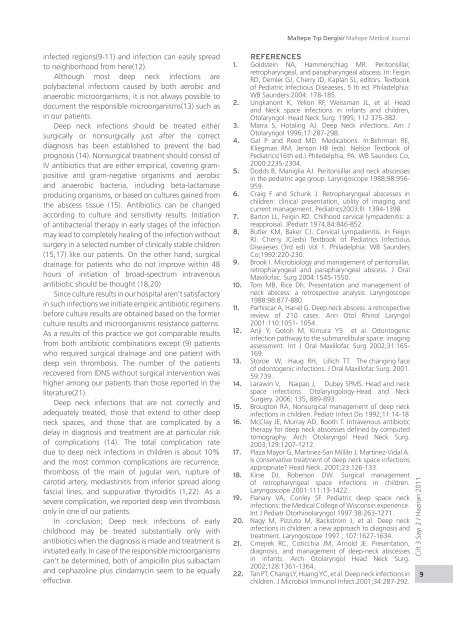Olgu Sunumu Medial Calcific Sclerosis (Mönckeberg) Case Report
Olgu Sunumu Medial Calcific Sclerosis (Mönckeberg) Case Report
Olgu Sunumu Medial Calcific Sclerosis (Mönckeberg) Case Report
You also want an ePaper? Increase the reach of your titles
YUMPU automatically turns print PDFs into web optimized ePapers that Google loves.
infected regions(9-11) and infection can easily spread<br />
to neighborhood from here(12).<br />
Although most deep neck infections are<br />
polybacterial infections caused by both aerobic and<br />
anaerobic microorganisms, it is not always possible to<br />
document the responsible microorganisms(13) such as<br />
in our patients.<br />
Deep neck infections should be treated either<br />
surgically or nonsurgically just after the correct<br />
diagnosis has been established to prevent the bad<br />
prognosis (14). Nonsurgical treatment should consist of<br />
IV antibiotics that are either empirical, covering grampositive<br />
and gram-negative organisms and aerobic<br />
and anaerobic bacteria, including beta-lactamase<br />
producing organisms, or based on cultures gained from<br />
the abscess tissue (15). Antibiotics can be changed<br />
according to culture and sensitivity results. Initiation<br />
of antibacterial therapy in early stages of the infection<br />
may lead to completely healing of the infection without<br />
surgery in a selected number of clinically stable children<br />
(15,17) like our patients. On the other hand, surgical<br />
drainage for patients who do not improve within 48<br />
hours of initiation of broad-spectrum intravenous<br />
antibiotic should be thought (18,20)<br />
Since culture results in our hospital aren’t satisfactory<br />
in such infections we initiate empiric antibiotic regimens<br />
before culture results are obtained based on the former<br />
culture results and microorganisms resistance patterns.<br />
As a results of this practice we got comparable results<br />
from both antibiotic combinations except (9) patients<br />
who required surgical drainage and one patient with<br />
deep vein thrombosis. The number of the patients<br />
recovered from IDNS without surgical intervention was<br />
higher among our patients than those reported in the<br />
literature(21).<br />
Deep neck infections that are not correctly and<br />
adequately treated, those that extend to other deep<br />
neck spaces, and those that are complicated by a<br />
delay in diagnosis and treatment are at particular risk<br />
of complications (14). The total complication rate<br />
due to deep neck infections in children is about 10%<br />
and the most common complications are recurrence,<br />
thrombosis of the main of jugular vein, rupture of<br />
carotid artery, mediastinitis from inferior spread along<br />
fascial lines, and suppurative thyroiditis (1,22). As a<br />
severe complication, we reported deep vein thrombosis<br />
only in one of our patients.<br />
In conclusion; Deep neck infections of early<br />
childhood may be treated substantially only with<br />
antibiotics when the diagnosis is made and treatment is<br />
initiated early. In case of the responsible microorganisms<br />
can’t be determined, both of ampicillin plus sulbactam<br />
and cephazoline plus clindamycin seem to be equally<br />
effective.<br />
Maltepe Tıp Dergisi/ Maltepe Medical Journal<br />
REFERENCES<br />
1. Goldstein NA, Hammerschlag MR. Peritonsillar,<br />
retropharyngeal, and parapharyngeal abscess. In: Feigin<br />
RD, Demler GJ, Cherry JD, Kaplan SL, editors. Textbook<br />
of Pediatric Infectious Diseaeses, 5 th ed. Philadelphia:<br />
WB Saunders:2004: 178-185.<br />
2. Ungkanont K, Yellon RF, Weissman JL, et al. Head<br />
and Neck space infections in infants and children,<br />
Otolaryngol. Head Neck Surg. 1995; 112 375-382.<br />
3. Marra S, Hotaling AJ. Deep Neck infections. Am J<br />
Otolaryngol 1996;17:287-298.<br />
4. Gal P and Reed MD. Medications. In:Behrman RE,<br />
Kliegman RM, Jenson HB (eds). Nelson Textbook of<br />
Pediatrics(16th ed.) Philedelphia, PA: WB Saunders Co,<br />
2000:2235-2304.<br />
5. Dodds B, Maniglia AJ. Peritonsillar and neck abscesses<br />
in the pediatric age group. Laryngoscope 1988;98:956-<br />
959.<br />
6. Craig F and Schunk J. Retropharyngeal abscesses in<br />
children: clinical presentation, utility of imaging and<br />
current management. Pediatrics2003;lll: 1394-1398<br />
7. Barton LL, Feigin RD. Chilhood cervical lympadenitis: a<br />
reapproisal. JPediatr 1974,84:846-852.<br />
8. Butler KM, Baker CJ. Cervical Lympadenitis. in Feigin<br />
RJ. Cherry JC(eds) Textbook of Pediatrics Infectious<br />
Diseaeses (3rd ed) Vol 1. Philadelphia: WB Saunders<br />
Co;1992:220-230.<br />
9. Brook I. Microbiology and management of peritonsillar,<br />
retropharyngeal and parapharyngeal abscess. J Oral<br />
Maxillofac. Surg 2004:1545-1550.<br />
10. Tom MB, Rice Dh. Presentation and management of<br />
neck abscess: a retrospective analysis. Laryngoscope<br />
1988:98:877-880.<br />
11. Parhiscar A, Har-el G. Deep neck abscess: a retrospective<br />
review of 210 cases. Ann Otol Rhinol Laryngol<br />
2001:110:1051- 1054.<br />
12. Ariji Y, Gotoh M, Kimura Y5 et al. Odontogenic<br />
infection pathway to the submandibular space: imaging<br />
assessment. Int J Oral Maxillofac Surg 2002;31:165-<br />
169.<br />
13. Storoe W, Haug RH, Lillich TT. The changing face<br />
of odontogenic infections. J Oral Maxillofac Surg. 2001.<br />
59:739.<br />
14. Larawin V, Naipao J, Dubey SPMS. Head and neck<br />
space infections. Otolaryngology-Head and Neck<br />
Surgery. 2006; 135, 889-893.<br />
15. Brougton RA, Nonsurgical management of deep neck<br />
infections in children. Pediatr Infect Dis 1992;11:14-18<br />
16. McClay JE, Murray AD, Booth T. Intravenous antibiotic<br />
therapy for deep neck abscesses defined by computed<br />
tomography. Arch Otolaryngol Head Neck Surg.<br />
2003;129:1207-1212.<br />
17. Plaza Mayor G, Martinez-San Millân J, Martinez-Vidal A.<br />
Is conservative treatment of deep neck space infections<br />
appropriate? Head Neck. 2001;23:126-133.<br />
18. Kirse DJ, Roberson DW. Surgical management<br />
of retropharyngeal space infections in children.<br />
Laryngoscope 2001:111:13-1422.<br />
19. Flanary VA, Conley SF. Pediatric deep space neck<br />
infections: the Medical College of Wisconsin experience.<br />
Int J Pediatr Otorhinolaryngol 1997:38:263-1271.<br />
20. Nagy M, Pizzuto M, Backstrom J, et al. Deep neck<br />
infections in children: a new approach to diagnosis and<br />
treatment. Laryngoscope 1997 ; 107:1627-1634.<br />
21. Cmejrek RC, Coticchia JM, Arnold JE. Presentation,<br />
diagnosis, and management of deep-neck abscesses<br />
in infants. Arch Otolaryngol Head Neck Surg.<br />
2002;128:1361-1364.<br />
22. Tan PT, Chang LY, Huang YC, et al. Deep neck infections in<br />
children. J Microbiol Immunol Infect.2001;34:287-292.<br />
Cilt 3 Sayı 2 / Haziran 2011<br />
9



